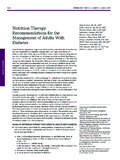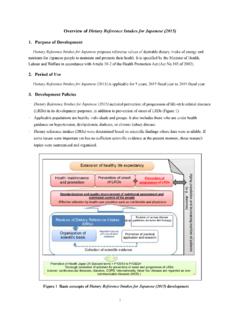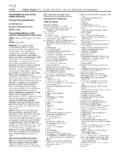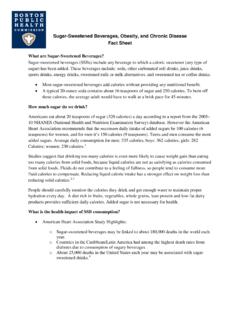Transcription of The Role of Glycemic Index & Glycemic Load on …
1 19201 E. MainstreetSuite 103 Parker, CO 80134 Phone: (303) 840-8787 Fax: (303) Role of Glycemic Index & Glycemic load on CarbohydrateFood Quality: A Status ReportG l y c e m i c I n d e x1 Table of ContentsExecutive Summary ..2 Introduction ..3 Carbohydrates and Glycemic Response Measures ..4 Table 1 ..5 Table 2 ..6 Table 3 ..8 Table 4 ..8 Table 5 ..8 The GI Measurement Issues and Controversy ..9 Factors Affecting the Variability of the Index ..9 Table 6 ..9 Table 7 ..9 Table 8 ..10 Table 9 ..11 Glycemic Index in the Clinical Setting.
2 12 Glycemic Index and Body Weight, Weight Loss and Satiety ..12 GI/GL and Body Weight ..12 Glycemic Index , Glycemic load and Weight Loss ..13 Glucose Release, Insulin Release and Insulin Sensitivity ..13 Hunger, Satiety, Palatability and Satisfaction with GI/GL Diets ..14 Glycemic Index , Glycemic load and Prevention and Treatment of Diabetes ..15 GI, GL and Prevention of Diabetes ..15 Text Box 1 Nutrition Recommendations and Interventions for Prevention of Diabetes ..17 Glycemic Index and Loading in Treating T2DM ..18 Text Box 2 Nutrition Recommendations for the Management of Diabetes CHO in Diabetes Management.
3 18 Glycemic Index , Glycemic load and Gestational Diabetes ..20 Pre-Diabetes and the Insulin Resistance Sydrome and GI/GL ..20 Glycemic Index , Glycemic load and Markers of Coronary Risk and Cardiovascular Disease ..21 GI/GL, Blood Lipids and Markers of Coronary Risk ..21 GI/GL, Stroke and Cardiovascular Disease ..21 Glycemic Index , Glycemic load and Cancer ..22 Breast Cancer ..22 Text Box 3 - Prospective Studies Which Show No Association of GI and GL with Breast Cancer ..23 Glycemic Index , Glycemic load and Colon Cancer Risk ..23 Glycemic Index , Glycemic load and Pancreatic Cancer.
4 24 Glycemic Index , Glycemic load and Other Cancers ..24 Summary for Glycemic Index and Glycemic load for all Cancers ..26 Glycemic Index for Athletes ..26 Conclusions ..27 List of Acronyms ..29 Glossary ..29 References ..322G l y c e m i c I n d e xCarbohydrate food quality has become a hot topic due to its link with Glycemic response and chronic diseases. Yet, Glycemic response as measured by Glycemic Index (GI) and Glycemic load (GL) is variable. Further, there is misleading use of GI and GL due to lack of understanding regarding what is being compared and that the comparison is of 50g of available CHO (not food) and 50g of glucose.
5 To add to this problem within and between lab variations, plant varietal differences and cooking methods produce other sources of variability. The measure is done with a single food eaten alone, but foods are not usually eaten alone, but in combination, thereby adding more variability. These sources of variability suggest that assigning numbers to individual foods would not only be difficult and too imprecise for food labeling, but also that it would fail to adequately inform the consumer. To add to the complexity, markedly different diets can have the same Glycemic score.
6 Thus, tying either GI or GL to chronic disease endpoints is very difficult and this has been shown in a number of instances. For example, data linking GI/GL to either weight maintenance or long-term weight loss is inconsistent, despite the fact that some studies indicated that low GI or GL diets, compared those higher in GI or GL, may be weakly associated with greater satiety and reduced hunger. In terms of the risk of type 2 diabetes mellitus (T2DM), high dietary GI or GL is associated in some studies. However, the pattern is inconsistent and has confounders such as age, BMI, lifestyle and other dietary factors especially dietary fiber.
7 Diets low in dietary fiber are strongly associated with increased risk of T2DM and the association is amplified when diets are high in dietary GI or GL. While data exist which both support and contradict benefits of low GI/GL diets in the management of diabetes, the American Diabetes Association recommends that diabetics consuming high GI diets switch to lower GI diets to help control postprandial are inconsistent on the role of low-GI diets on risk factors for coronary heart disease (CHD) and cancer. Some studies show a small reduction in total cholesterol and markers of inflammation for hyperlipidemic subjects selecting low GI diets compared with high GI diets.
8 The role of GI or GL in cancer risk is inconsistent and depends on the type of cancer. While case-control studies showed positive associations between GI and GL intake for a number of types of cancers, pooled cohort studies showed no consistent associations between colorectal, pancreatic, breast cancer or other cancer risks and GI or GL. Further studies are needed which improve the assignment of GI and GL to the diet along with careful choice of subjects in the carbohydrate in the diet appears to trump the GI or GL of the diet when considering fuel for exercise.
9 For the meal prior to endurance exercise, data indicate there may be a competitive advantage to selecting low-to-moderate GI/GL foods, and limited data indicating an advantage of a higher GI/GL diet or food for replenishing glucose after SummaryGlycemic indexG l y c e m i c I n d e x3 Scrutiny surrounding the quality of carbohydrate (CHO) foods has in the last decade started to approach that of fats. Large epidemiological studies have linked the Glycemic response to chronic diseases by associating low Glycemic Index (GI) or Glycemic load (GL) diets with a number of positive health impacts.
10 These include: (1) improved Glycemic control in diabetic subjects, which is associated with reduced risk of diabetes, (2) more favorable lipid profiles, which are associated with lower risk of cardiovascular disease, and (3) reduced markers of inflammation, which are associated with lower risk of metabolic syndrome, overweight and other chronic diseases. A few studies have shown associations between dietary GI/GL and the risk of colon, breast and other cancers. Despite studies that indicate associations, there are also a number of studies that fail to link GI/GL of the diet with health and disease risk.







